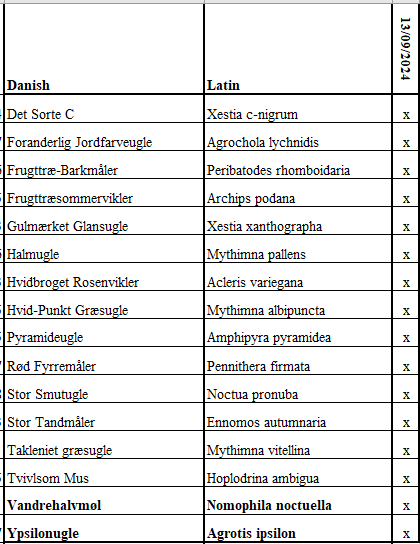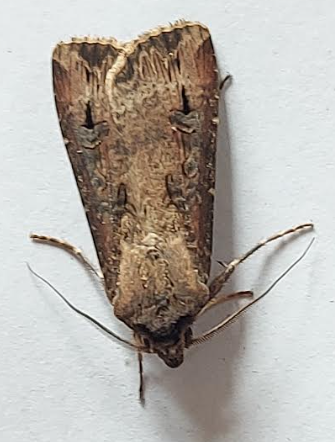Gedser Fuglestation Blog
Her på Gedser Fuglestations blog bringes korte nyheder i dagbogsformat om hændelser på fuglestationen.
And then they were there
The ringing
Today Robert and I were happy to have each others help, because we finally got what we wanted, a busy morning with in total 121 birds, 115 of them new and 6 recaptures. It was mainly Robins “Rødhals”, 49 new ones and Chiffchaff “Gransanger”, 33 new. As to expect, the big majority was first calendar year birds. Else there was nothing out of the ordinary in the nets, 2 female Pied Flycatchers “Broget Fluesnapper” and one pretty Lesser Whitethroat “Gærdesanger” were nice. The more birds, the longer the data entry and the more tired the ringers and the shorter the blog. In that sense, let´s hope for another good day tomorrow.
This time we had more moths and also a few new for here. We did catch 16 different species and the new ones were the Rush Veneer (Vandrehalvmøl) and the Ipsilon Dart Moth (Ypsilonugle).


Vandrehalvmøl (Rush Veneer)

Ypsilonugle (Ipsilon Dart Moth)
Migration count at Gedser Odde
by Lara W
A relatively still morning with clear skies brought us a good number of migrating birds today – 1121 individuals of 32 species, some of which were a little different from what we have been seeing over the last couple of weeks. Highlights were a flock of 5 Crane/Trane (Grus grus), a juvenile Montagu’s Harrier/Hedehøg (Circus pygargus), and a Cuckoo/Gøg (Cuculus canorus). The Montagu’s was especially exciting, gliding close enough for us to properly enjoy the variety of colours within the plumage. A small flock of Great white egret/Sølvhejre (Ardea alba), and 2 Red Kite/Rød Glente (Milvus milvus), also gave us a few minutes of diversion, although they did not migrate. Still, a lovely sight in the early morning sunlight, where the white wings of the egrets turned almost fully translucent.
Out to sea, a relatively steady stream of scoter (Common scoter/Sortand (Melanitta nigra), Velvet Scoter/Fløjlsand (Melannita fusca)), Wigeon/Pibeand (Anas Penelope), and Sandwich tern/Splitterne (Thalasseus sandvicensis) flew by, with occasional mixed flocks including Teal/Krikand (Anas crecca), Pintail/Spidsand (Anas acuta), and Shoveler/Skeand (Anas clypeata). A long line of almost 100 Cormorant/Skarv (Phalacrocorax carbo) above the horizon provided variation from the bunched-up groupings of the seaducks. However, the real excitement was reserved for a pair of divers – one Red-throated Diver/Rødstrubet Lom (Gavia stellata) and one Black-throated Diver/Sortstrubet Lom (Gavia arctica) – that flew fairly close to the coast, allowing us a detailed view of their flight action and colouring. Their distinctly large feet sticking out behind are a tell-tale indicator, and with both species flying so close together, Larissa and I were able to fully appreciate the differences between them in terms of shape, overall size, and plumage. A couple of Greenshank/Hvidklire (Tringa nebularia) were spotted too, and a small flock of Dunlin/Almindelig Ryle (Calidris alpina).
Passerines were a little thin on the ground today, with only a few Swallow/Landsvale (Hirundo rustica) and White wagtail/Hvid Vipstjert (Motacilla alba) making the crossing, plus a small flock of 5 Linnet/Tornirisk (Linaria cannabina). Around halfway through the morning, the resident rosebush sparrow (mixed flock Tree/Skovspurv and House/Gråspurv) flock suffered a casualty, when a hungry Sparrowhawk/Spurvehøg (Accipiter nisus) snapped up a last-minute meal before migrating south-west. Unfortunate for the sparrow, but a perfect demonstration for us of this small raptor’s fast reflexes and excellent hunting ability!
Lara Winsloe, Larissa Britton, Robert Luttik, Hanelie Sidhu



